Lotus Flowers: 8 Locations in Japan and Photography Tips

Lotus flowers, blooming from mid-June to early August, are very loved in Japanese culture. Learn the best 8 lotus flower locations in Japan and photography tips.
Lotus Flowers: Meaning and Blooming Time in Japan
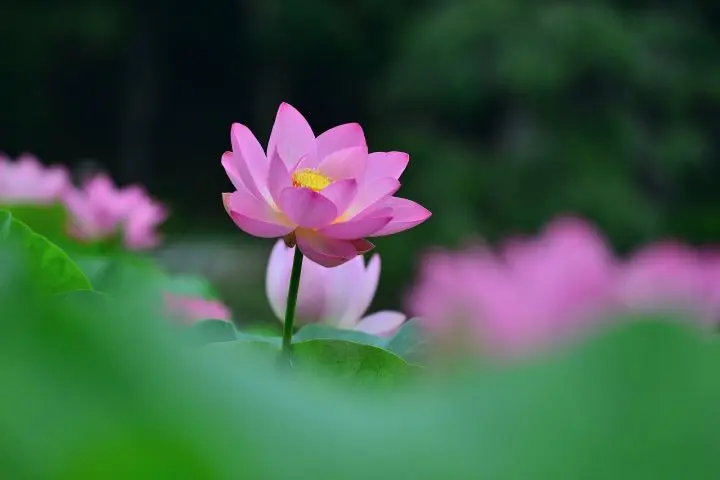
Photo by Pixta
Lotus flowers, loved all around Japan and deeply connected to Buddhist culture, bloom from mid-June to early August. The best time to see them is in the early morning hours, between 6:00 and 10:00 AM.
In Japan, the lotus flower embodies purity and enlightenment. This powerful symbolism arises from its ability to bloom immaculately from the mud at the bottom of ponds, a metaphor for finding purity amidst the world's darkness. This makes the lotus a treasured motif, often seen in flower arrangements on Buddhist altars and in Buddhist art.
Read on to learn eight great locations to view lotus flowers in Japan and tips on how to capture them in pictures.
Top 8 Lotus Flower Locations in Japan
1. Tokyo: Shinobazu Pond in Ueno
2. Ibaraki: The Lotus Root Fields in Tsuchiura
3. Chiba: Suigo Sawara Ayame Park
4. Kyoto: Hokongoin Temple
5. Uji, Kyoto: The Phoenix Hall of Byodoin Temple
6. Nara: Kikoji Temple
7. Usuki, Oita: The Lotus Pond in the Usuki Stone Buddha Complex
8. Akita: Senshu Park
Lotus Flower Viewing and Photography Tips
1. Tokyo: Shinobazu Pond in Ueno
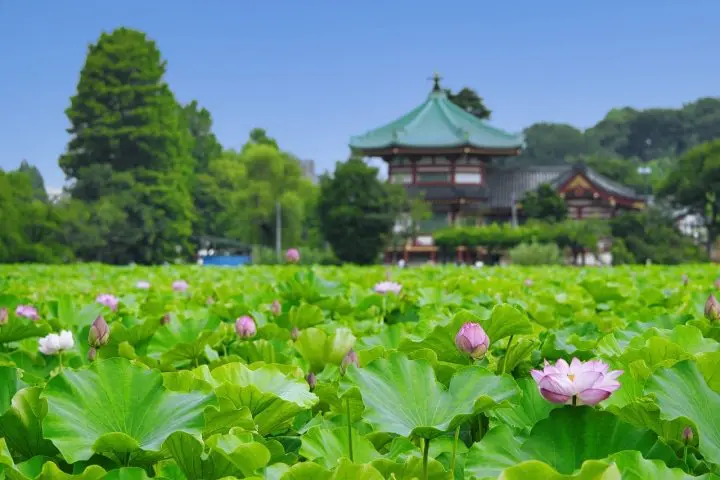
Photo by Pixta
The most famous location for viewing lotus flowers in Tokyo is Shinobazu Pond in Ueno. The pond surrounding the Bentendo Hall was turned into a paddy field for a brief period during World War II but was restored as a pond right after the war.
There are five major varieties of lotus flowers blooming here from around mid-July to mid-August, including a unique variety called Shinobazuike Madara Lotus, which is endemic to this pond.
Shinobazu Pond is an excellent location if you wish to take photos of the blooms with urban scenery in the background or with the crimson silhouette of the Bentendo Hall. Be aware, though, that as early as 8:00 AM, the park is visited by many photography enthusiasts eager to capture the lotus blooms in photos.
Other excellent lotus flower destinations in Tokyo are the Jindai Botanical Gardens in Chofu or the Koishikawa Korakuen Garden.
Lotus blooming period in the Tokyo area: early July - mid-August
↑ Return to the top of article.
2. Ibaraki: The Lotus Root Fields in Tsuchiura
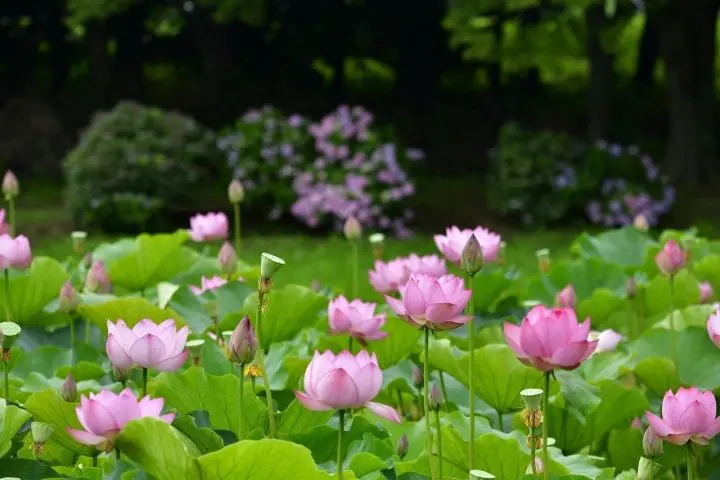
Photo by Pixta
Tsuchiura City is one of the largest lotus root production areas in Japan. The ryzhome is grown into the wetlands around Lake Kasumigaura. Visit this area in early summer and you'll see the lotus plats covering hectares of wetland--it's a truly impressive sight!
Generally from around mid-July to early August, the beautiful pink blooms grace the fields with their appearance creating splendid contrast with the lush greenery on top of the water.
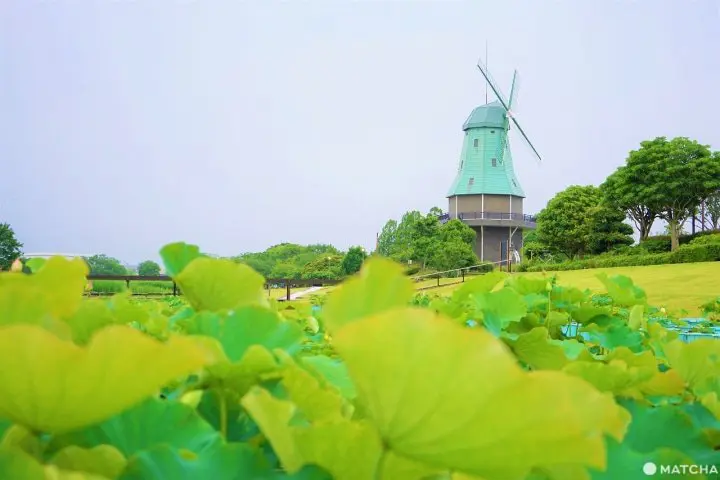
Tsukuba-Kasumigaura Ring Ring Road, a famous local cycling route, runs right along the picturesque lotus root fields! Kasumigaura Park, known for its iconic windmill, is another location in the area where you can enjoy viewing various types of gorgeous lotus flowers.
Lotus blooming period in Tsuchiura: mid-July - early August
Official website: Kasumigaura Park
↑ Return to the top of article.
3. Chiba: Suigo Sawara Ayame Park
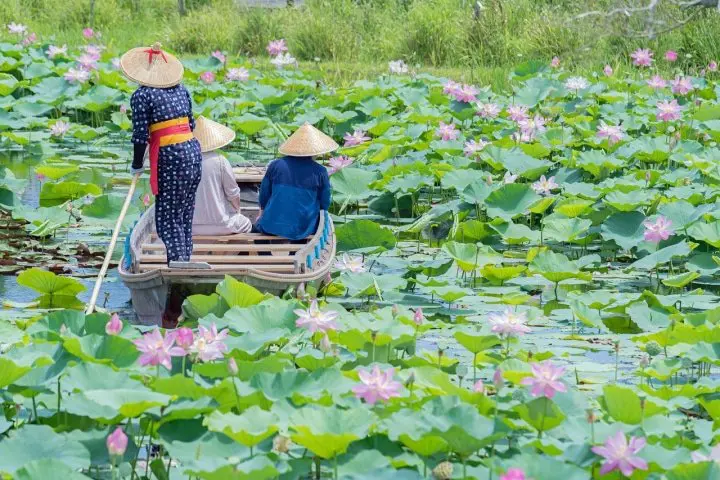
Photo by Pixta
Located in Katori, the Suigo Sawara Ayame Park is an 8-hectare space filled with all sorts of botanical wonders. The park has numerous waterways and bridges that allow visitors to experience the majesty of the lotuses by boat. It is one of the locations that preserve the waterway landscape of the city from the old.
With over 300 lotus varieties, Suigo Sawara Ayame Park is one of the best places to see lotus flowers in eastern Japan. Conveniently located close to Narita Airport and easily accessible from Tokyo, it is the ideal destination for any lotus viewing itinerary.
In July, the park holds the Lotus Flower Festival (Hasu matsuri), offering events, workshops, and even the chance to enjoy lotus tea!
Lotus blooming period in Chiba: July
Official website: https://ayamepark.jp/
↑ Return to the top of article.
4. Kyoto: Hokongoin Temple
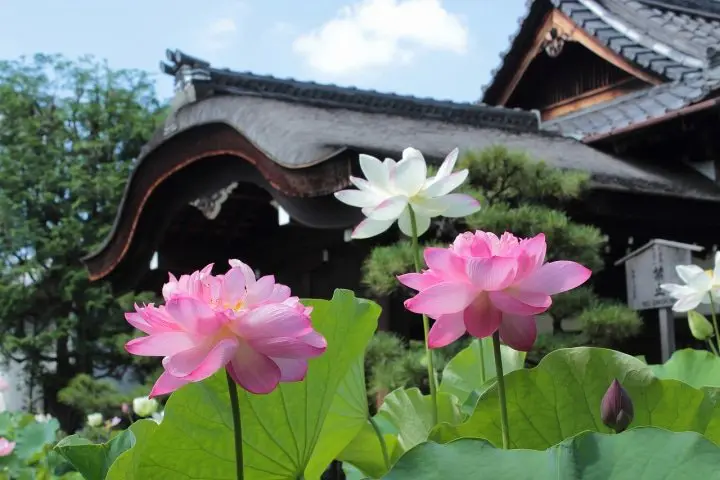
Photo by Pixta
Dating back to the Heian period (794-1185), Hokongoin Temple is famous for its magnificent lotus flowers during the summer. Known as the "lotus temple," Hokongoin is ranked in the top 20 temples to view flowering plants in western Japan.
Visitors can take in the potted varieties that are placed all over the picturesque temple as well as marvel at the large lotus pond. The large leafy stalks and the vibrant pink blossoms make visitors feel like they are viewing lotus blossoms in an untouched wilderness.
Every year in July, the temple holds a lotus viewing event starting from 7:30 AM until 13:00 (no reservation needed).
Lotus blooming period in Kyoto: July
Official website: http://houkongouin.com/
↑ Return to the top of article.
5. Uji, Kyoto: The Phoenix Hall of Byodoin Temple
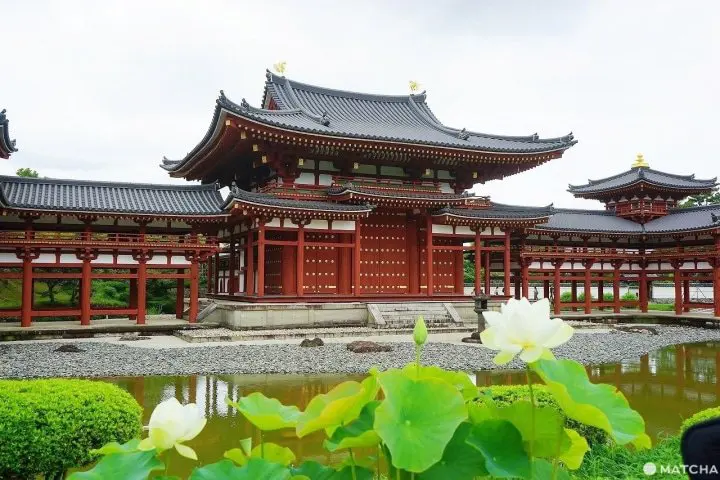
Known for being depicted on the back of the 10 yen coin, Byodoin Temple is also known for a unique species of lotus only grown on the temple grounds!
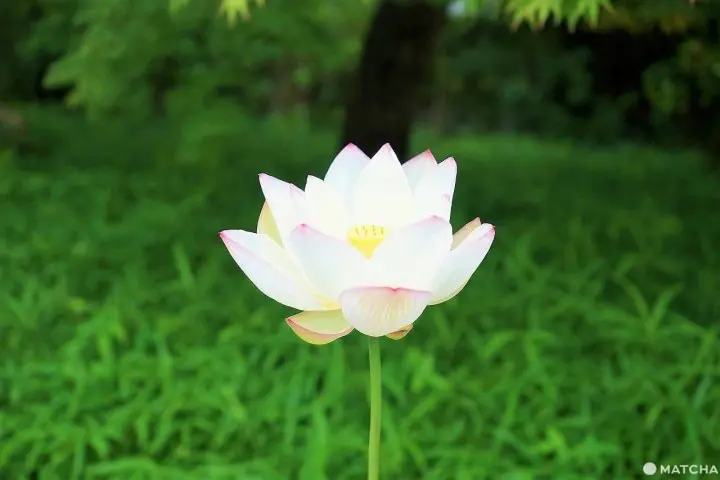
In 1999, scientists dug up and found lotus seeds in one of the ponds on the grounds and since then a beautiful pure white blossom with a honey yellow heart has been seen all over the grounds. The variety is one of dozens that included potted lotus plants for viewers to see at this temple.
Lotus blooming period in Uji: early July to late July
Official website: https://www.byodoin.or.jp/en/
↑ Return to the top of article.
6. Nara: Kikoji Temple
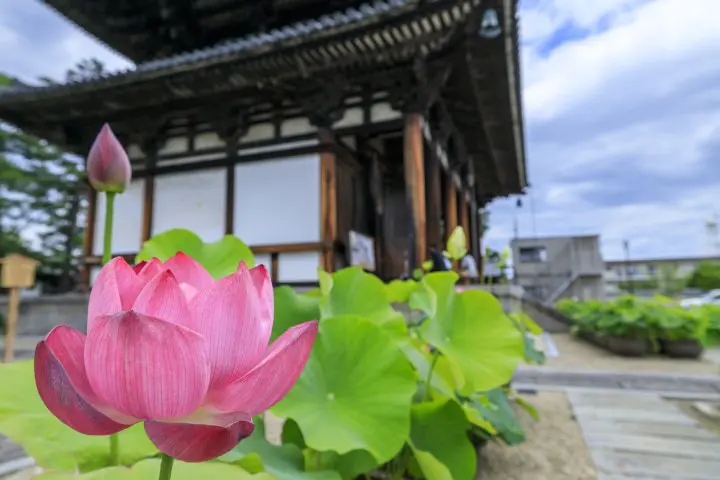
Photo by Pixta
Visitors can enjoy getting right up close to these lotuses in a very different kind of way. Nara is home to the "lotus road," a series of three temples in the city that are great places to view the lotus flowers.
Kikoji is also the place to go for those of you who wish to get close-up photos of the lotus flowers. There are around 80 lotus varieties that grace the temple grounds with their white and pink colors.
Be advised that tripods (as well as monopods) are not allowed on the temple grounds so you will have to keep steady to take your images.
Lotus blooming times in Nara: mid-June to early August
Official website: https://kikouji.com/
↑ Return to the top of article.
7. Usuki, Oita: The Lotus Pond in the Usuki Stone Buddha Complex
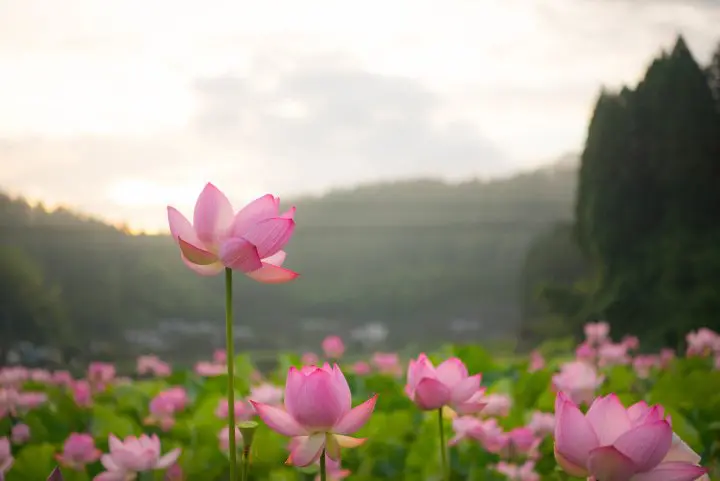
Photo by Pixta
The Usuki Stone Buddhas are figures of Buddhist deities and saints carved in rock; they were created from the late Heian Period to the Kamakura Period (1185 - 1333).
The entire complex was designed in the image of the Buddhist Pure Land; a lotus pond can be found in front of the statuary complex. The lotus blooms can be enjoyed here from around the end of June until the end of July. Take the time to leisurely walk around the vast grounds and take in the splendid views that inspired deeply religious feelings in the people who used to live here centuries ago.
Lotus blooming period in Usuki: early July until mid-August
Official website: https://sekibutsu.com/english
↑ Return to the top of article.
8. Akita: Senshu Park
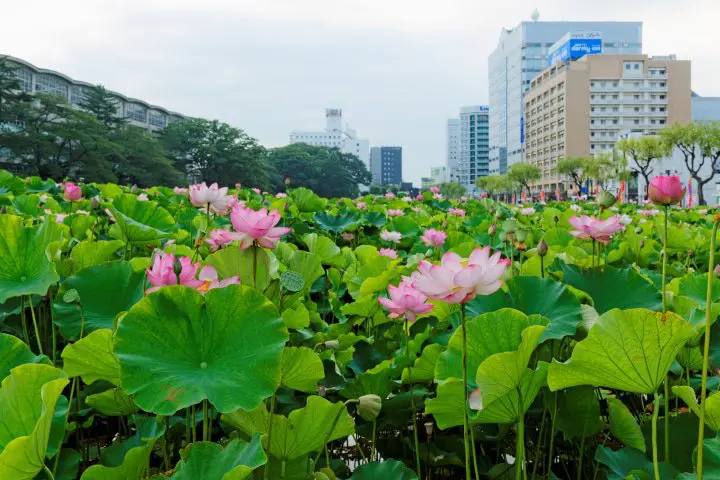
Photo by Pixta
Senshu Park can be reached in only 10 minutes on foot from the JR Akita Station. The park was built on the grounds of the garden of Kubota Castle, the seat of power of the Akita Domain in the Edo period (1603-1868). The castle moat has become a pond that attracts visitors eager to admire the lotus flowers in summer.
The vibrant pink blossoms fill up the castle moat every year from mid-July into mid-August. The best time to view them at peak bloom is during early August and visitors can take in both the castle moat as well as Kogetsu Pond for their viewing experience.
Lotus blooming period in Akita: mid-July to mid-August
Official website: Senshu Park
↑ Return to the top of article.
Lotus Flower Viewing and Photography Tips
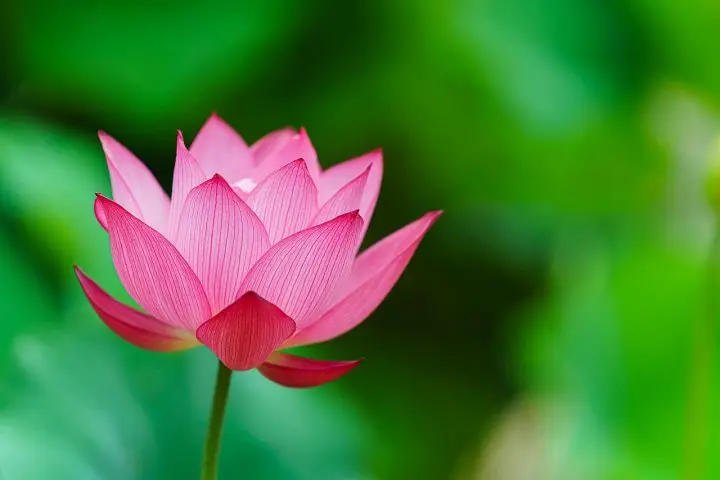
Photo by Pixta
Lotus flowers bloom and look best early in the morning when it's not very hot outside. It is even said that if you go at dawn and listen very carefully, you can even hear the crack of the petals opening in unison.
If you're aiming for a beautiful close-up, try to make sure that your main light source is behind the flowers; you have a better chance to capture the transparent quality of their petals. If you're shooting at a pond, please be careful where you step and not get too close to the flowers.
Enjoy the Splendid Lotus Flowers in Japan
Japan's love of lotus blossoms has a long history. Take the time to admire the serenity of these flowers and the beautiful ponds and temple grounds where they grow.
Read also
All pictures from Pixta
Travel writer and assistant editor at MATCHA with extensive travel around the Osaka, Kyoto, and Wakayama areas. A Kansai insider who knows their Akashiyaki from their Takoyaki, Iain enjoys getting authentic stories from traditional craftspeople and interesting creators. Particularly fond of temples and shrines, Iain delves deep into the crossroads of tradition and modernity in his eight-plus years living and writing about Japan.






























![[2026] Top 5 Strawberry Picking Spots in Tokushima, Naruto| Farms and Access Guide for January to May](https://resources.matcha-jp.com/resize/720x2000/2025/03/06-227165.webp)



